
|
Sale 122
June 13-16 Pre-Long Beach Auction
| Lot |
Photo |
Description |
Realized |
Lot 1701 |
 |
Great Britain. Sovereign, 1823. S.3800; Fr-376; KM-682. Weight 0.2355 ounce. George IV. Leaureate head left. Reverse; Crowned shield. Rare date. PCGS graded VF-35. In special PCGS Ship of Gold holder which contains One Pinch of Gold Dust recovered from the S.S. Central America treasure.
Special PCGS number 674253.35/35474715. Estimated Value $1,500 - UP
Much of 1823 was consumed with discussion about the reform of the penal system in Great Britain. Whereas the death penalty was previously prescribed for a host of offences, many of which would be considered minor crimes by modern standards, in July 1823, Prime Minister Robert Peel assisted in pushing through five parliamentary acts that abolished capital punishment for over 100 offences. The Judgement of Death Act permitted judges to commute death sentences to life imprisonment or transportation for all capital offences except murder and treason while the Transportation Act allowed for the shipping of convicts to penal colonies in Australia where they became forced labor for various public works. The Gaols Act attempted to reform prisons by requiring the separation of male and female prisoners and guards, ensuring regular visits by chaplains, and prohibiting the use of irons and manacles.
In addition to penal reform, a concern for Great Britain in 1823 was the outbreak of the First Anglo-Asante War (1823-1826) in the Gold Coast of Africa. The conflict erupted after a serviceman in the Royal Africa Corps was kidnapped and murdered by a group of Asante warriors. An initial British reprisal was a failure, but when the Asante offered to negotiate a settlement of the issue as well as to territorial disputes the governor, Sir Charles McCarthy refused and instead prepared a punitive military expedition. The campaign, which actually began in January 1824 was an utter disaster, in which the British forces ran out of ammunition and McCarthy was killed. His skull was reportedly rimmed with gold and subsequently used as a drinking cup by Asante rulers.
View details and enlarged photos
Realized
$4,080 |
|
Lot 1702 |
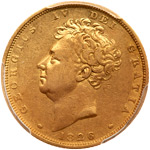 |
Great Britain. Sovereign, 1826. S.3801; Fr-377; KM-696. Weight 0.2355 ounce. George IV. Bare head left. Reverse; Crowned shield. PCGS graded AU-50. In special PCGS Ship of Gold holder which contains One Pinch of Gold Dust recovered from the S.S. Central America treasure.
Special PCGS number 674274.50/35474732. Estimated Value $1,250 - UP
On 24 February 1826, Great Britain and the Burmese Empire signed the Treaty of Yandabo, thereby ending the First Anglo-Burmese War (1824-1826). This conflict had evolved from Burmese expansion on the borders of British India and became the most expensive conflict in terms of men and money in the history of British India. However, it ended with a British victory and the Treaty of Yandabo compelled the Burmese Empire to cede many of its border territories and pay a crippling indemnity. The treaty marked the beginning of the collapse of the previously formidable Burmese Empire and the strangle hold of British power in India.
In the summer of this year, which saw the Tories win a resounding elected majority for the Prime Minister, Robert Jenkinson, the Earl of Liverpool, the United Kingdom also suffered through a three-month drought and heat wave that was the second hottest since temperatures began to be recorded in 1659. In 1826, the situation also remained hot for British forces in the Gold Coast, where they continued the First Anglo-Asante War (1823-1831). On 7 August, John Hope Smith, the new British governor, successfully defended Accra from the Asante handily defeated them by firing rockets into the midst of the enemy. The terror inspired by these new weapons and the devastation they caused ended the immediate threat of the Asante Empire to British colonialism in the Gold Coast and permitted the breathing space to establish the Pra River as the border between the two powers in 1831.
View details and enlarged photos
Realized
$2,520 |
|
Lot 1703 |
 |
Great Britain. Sovereign, 1827. S.3801; Fr-377; KM-696. Weight 0.2355 ounce. George IV. Bare head left. Reverse; Crowned shield. PCGS graded EF-40. In special PCGS Ship of Gold holder which contains One Pinch of Gold Dust recovered from the S.S. Central America treasure.
Special PCGS number 674277.40/35474736. Estimated Value $1,000 - UP
The political situation in Great Britain was thrown into some degree of turmoil in 1827. Not only had the always poor health of the unpopular George IV begun to fall into a steep decline, but Robert Banks Jenkinson, the Earl of Liverpool and the Prime Minister who had guided the United Kingdom through the Napoleonic Wars and the Congress of Vienna that ended them, retired from Whitehall after being struck down by a cerebral hemorrhage in February 1827. George Canning was chosen to succeed Liverpool as the new Prime Minister on 10 April 1827. This appointment offended both Arthur Wellesley, the famous Duke of Wellington who had been named Commander-in-Chief of the British Armed Forces in January, and Sir Robert Peel, both of whom considered themselves better candidates. Their refusal to work with Canning effectively split the Tory party into two hostile camps known as the High Tories and the Canningites. After only 119 days in office, Canning fell ill and died on 8 August 1827. To this day he still holds the record for the shortest term of a British Prime Minister.
At the same time that British Parliament suffered from the upheavals attendant upon the frequent changes of Prime Minister and factionalism, 1827 marked the first year of direct British involvement in the ongoing Greek War of Independence (1821-1829). Whereas previously Great Britain had called upon both the Ottoman Empire and the Greek rebels to cease hostilities, on 6 July, Britain, France, and Russia signed the Treaty of London, which demanded the creation of a Greek state through mediation of the European powers. Trusting in its overwhelming naval power to crush the rebellion in Greece, the Ottomans refused to accept the treaty. Although he was ordered to use force only as a last resort, on 20 October 1827, Admiral Edward Coddington and the British Mediterranean fleet incited a battle with the combined Turkish and Egyptian fleet at Navarino that resulted in the annihilation of the Ottoman navy. This battle, which was the last to be conducted by ships entirely under sail, had the effect of guaranteeing the survival of the fledgling Greek state, but was viewed as a diplomatic atrocity in London.
View details and enlarged photos
Realized
$1,800 |
|
Lot 1704 |
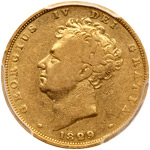 |
Great Britain. Sovereign, 1829. S.3801; Fr-377; KM-696. Weight 0.2355 ounce. George IV. Bare head left. Reverse; Crowned shield. PCGS graded VF-35. In special PCGS Ship of Gold holder which contains One Pinch of Gold Dust recovered from the S.S. Central America treasure.
Special PCGS number 674278.35/35474737. Estimated Value $700 - UP
The most important event of 1829 in Great Britain was the passage of the Catholic Emancipation Act on 13 April. This new law repealed earlier acts of 1672 and 1728 which had been designed to disenfranchise and otherwise penalize Roman Catholics in the United Kingdom. The 1829 legislation was intended to avoid a looming civil war in Ireland by reconciling Protestants and Catholics, but was extremely divisive in Parliament. Although the Prime Minister and Duke of Wellington, Arthur Wellesely, who had previously gained glory for himself in the Napoleonic Wars, was personally opposed to the act, he endorsed it for the good of the state and threatened to resign if it did not receive the king's royal assent. When insulted for his support of the bill in Parliament by George Finch, the Earl of Winchilsea, the Duke of Wellington challenged him to pistol duel. This took place on 21 March. Wellington's shot was far from the mark and Winchilsea purposely shot into the air, thereby fulfilling the requirements of honor without real bloodshed.
In addition to these tumultuous events, 1829 saw several notable advances in the United Kingdom. In this year and in connection with the Catholic Emancipation Act, Kings' College London was established as the first British secular university. On July 4, the first coach bus service was introduced in London by the entrepreneur George Shillibeer and on 29 September, the first "bobbies" began to patrol the city following the creation of the Metropolitan Police Service.
View details and enlarged photos
Realized
$1,620 |
|
Lot 1705 |
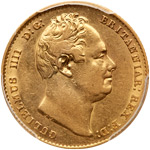 |
Great Britain. Sovereign, 1837. S.3829B; Fr-383; KM-717. Weight 0.2355 ounce. William IV. Bare head right. Reverse; Crowned shield. PCGS graded AU-55. In special PCGS Ship of Gold holder which contains One Pinch of Gold Dust recovered from the S.S. Central America treasure.
Special PCGS number 674262.55/35474720. Estimated Value $1,250 - UP
On 20 June 1837, William IV, the third son of George III died without a legitimate heir (although he left behind at least eight illegitimate children by the actress Dorothea Jordan). Lacking any surviving sons or daughters of his own through his marriage to Adelaide of Saxe-Meinigen, the succession to the throne of the United Kingdom devolved upon his 18-year-old niece, Victoria of Kent. Although the United Kingdom had been united to the German Kingdom of Hanover since the time of George I (1714-1727), the medieval Salic Law that governed succession in Hanover did not recognize female heirs and thus the link between the two kingdoms was severed with the death of William IV.
While the succession of Queen Victoria was by far the most important event in Great Britain in 1837, this year was notable for several major advancements. In February, a government inquiry into postal reform began to discuss the possibility of carrying letters in a separate sheet of folded paper with a "bit of paper" affixed to indicate that the cost of postage had been paid. From this discussion evolved the first envelopes and postage stamps, which were introduced in 1840. Other advancements of 1837 involved the breaking of racial barriers. On 17 August, John Kent became the first black police officer in the United Kingdom and on 9 November, Moses Montefiore became the first Jew to receive a knighthood, thanks to his assistance in financing the government's Slavery Abolition Act of 1833 and other philanthropic work.
View details and enlarged photos
Realized
$2,400 |
|
Lot 1706 |
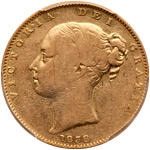 |
Great Britain. Sovereign, 1838. S.3852; Fr-387; KM-736.1. Weight 0.2355 ounce. Victoria. Young head. Reverse; Crowned shield. First year of issue. Scarce. PCGS graded VF-35. In special PCGS Ship of Gold holder which contains One Pinch of Gold Dust recovered from the S.S. Central America treasure.
Special PCGS number 674160.35/35474694. Estimated Value $1,000 - UP
More than a year after the death of William IV, the coronation of his niece as Queen Victoria took place at Westminster Abbey on 28 June 1838. Despite opposition by both the Tory and Radical parties in Parliament, the coronation was turned into a day of widespread popular celebration that established the model for the lavish spectacles that later marked British coronations and royal weddings in the 20th century. Previously, only members of the peerage had taken part in coronation ceremonies. The festivities included a grand public procession, a fireworks display, and a four-day fair in Hyde Park, all of which attracted an estimated 400,000 visitors to London. Due to Victoria's youth (she was only 19 years old at the time of the coronation) it was felt that her head and neck would be unable to support the full weight (5 lbs.) of St. Edward's Crown--the crown used for the coronation of British monarchs since the restoration of Charles II in 1660--and therefore a smaller Imperial State Crown was made for Victoria's coronation.
At the same time that 1838 was a year of celebration for the monarchy, it was also a year of social and political disturbance in the United Kingdom. The publication of the People's Charter by the London Working Men's Association ignited the movement known as Chartism, which fought for universal male voting rights without property qualifications. Likewise, the national Anti-Corn Law League-middle class moral crusading organization--was formed to exert pressure on the government to repeal the 1815 Corn Law that taxed imported wheat and raised the price of bread a t a time when factory owners were cutting wages. It became the first powerful national lobby group to influence politics and provided the model for subsequent organizations. Rather more tragic was the outcome of an agricultural workers' protest in Kent led by the mentally-ill John Nichols Tom, who presented himself to his followers as Sir William Percy Honeywood Courtney, King of Jerusalem. After shooting the brother of a local constable when he attempted to arrest him, Tom and eight of his associates were killed in a skirmish with the 45th Regiment of Foot on 31 May 1838 at Bossenden Wood-an event that is sometimes described as the last battle to take place on English soil.
View details and enlarged photos
Realized
$3,120 |
|
Lot 1707 |
 |
Great Britain. Sovereign, 1842. S.3852; Fr-387e; KM-736.1. Weight 0.2355 ounce. Victoria. Young head. Reverse; Crowned shield. PCGS graded VF-30. In special PCGS Ship of Gold holder which contains One Pinch of Gold Dust recovered from the S.S. Central America treasure.
Special PCGS number 674168.30/35474702. Estimated Value $500 - UP
View details and enlarged photos
Realized
$1,080 |
|
Lot 1708 |
 |
Great Britain. Sovereign, 1846. S.3852; Fr-387e; KM-736.1. Weight 0.2355 ounce. Victoria. Young head. Reverse; Crowned shield. PCGS graded EF-40. In special PCGS Ship of Gold holder which contains One Pinch of Gold Dust recovered from the S.S. Central America treasure.
Special PCGS number 675691.40/35671945. Estimated Value $500 - UP
View details and enlarged photos
Realized
$1,110 |
|
Lot 1709 |
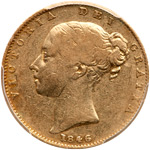 |
Great Britain. Sovereign, 1846. S.3852; Fr-387e; KM-736.1. Weight 0.2355 ounce. Victoria. Young head. Reverse; Crowned shield. PCGS graded VF-35. In special PCGS Ship of Gold holder which contains One Pinch of Gold Dust recovered from the S.S. Central America treasure.
Special PCGS number 674260.35/35474717. Estimated Value $500 - UP
View details and enlarged photos
Realized
$1,320 |
|
Lot 1710 |
 |
Great Britain. Sovereign, 1847. S.3852; Fr-387e; KM-736.1. Weight 0.2355 ounce. Victoria. Young head left. Reverse; Crowned shield. PCGS graded AU-55. In special PCGS Ship of Gold holder which contains One Pinch of Gold Dust recovered from the S.S. Central America treasure.
Special PCGS number 675692.55/35671946. Estimated Value $500 - UP
The ongoing Great Famine in Ireland (1845-1852), which ultimately resulted in the deaths of a million people and the emigration of another million, was at its most severe in 1847. The situation was so dire in this year that a group of aristocrats, banker, and philanthropists took it upon themselves to found the British Relief Association in an attempt to provide aid. The funding of the relief effort was supported by donations, including £2,000 (the largest individual donation) from Queen Victoria, and over the course of eight months managed to provide food and clothing to some 200,000 Irish children.
At the same time that the British Relief association was providing aid to starving Ireland, Great Britain was also reeling from a financial panic that had ensued when a stock market bubble related to railway development collapsed. The Bank Charter Act of 1844, which required all banknotes to be backed by gold or government debt, was briefly suspended in 1847 in the wake of the sudden failure of many non-bank financial companies. On a more positive note, 1847 also saw the institution of the Factory Act to limit the British working day to 10 hours for women and boys aged 13-18, the foundation of the Vegetarian Society of the United Kingdom (the oldest in the world), and the purchase of William Shakespeare's birthplace in Stratford-upon-Avon by the United Shakespeare Company in order to preserve it.
View details and enlarged photos
Realized
$1,440 |
|
Lot 1711 |
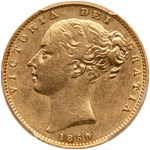 |
Great Britain. Sovereign, 1850. S.3852C; Fr-387e; KM-736.1. Weight 0.2355 ounce. Victoria. Young head left. Reverse; Crowned shield. PCGS graded AU-53. In special PCGS Ship of Gold holder which contains One Pinch of Gold Dust recovered from the S.S. Central America treasure.
Special PCGS number 674157.53/35474689. Estimated Value $500 - UP
In 1847 a Greek mob attacked the home of a Gibraltarian merchant named Don Pacifico in Athens at Easter. Because he was a British citizen (with political connections in Portugal and to the Greek Jewish community) a demand was made that the government of Greece repay him for the damages to his home and the monies taken by his attackers in 1848. This was flatly refused on the grounds that the value of Don Pacifico's itemized list of damaged and stolen possessions was impossibly high. When King Otto of Greece stopped paying back a British loan in 1849, Lord Palmerston, the British Foreign Secretary, took matters into his own hands. On 22 January 1850, he directed Admiral Sir William Parker to impose a blockade on the Piraeus and seize the small Greek fleet in order to compel Otto to give satisfaction in the so-called Don Pacifico affair and settle other disputes with respect to the British protectorate of the United States of the Ionian Islands. Although this application of gunboat diplomacy had the desired effect of obtaining compensation for Don Pacifico, it was accompanied by diplomatic fallout with France, which, along with Russia, shared in the protection of Greece. In the aftermath of the incident, Parliament closely examined its foreign policy and in June the House of Lords voted to rebuke Palmerston for his approval of Parker's coercive actions. It was, however, proposed in the House of Commons that this censure should be reversed. This motion was carried after four nights of debate and a famous 5-hour speech by Palmerston in which he compared the dignity of the British subject to that of the ancient Roman citizen and the reach of the British Empire to that of the Roman Empire to protect that dignity.
At the same time that 1850 was a year of problematic international entanglements for Parliament, it was also a peculiar and remarkable year for Queen Victoria. On 27 June, she was assaulted by the mentally-ill Lieutenant Robert Pate as she went to her coach following a visit to her dying uncle in Piccadilly. He struck her such a blow on the head with his cane that it crushed her bonnet and drew blood. Victoria survived the attack, but the mark on her forehead remained for more than a decade. Pate was subsequently convicted of assault and sentenced to transportation to Tasmania. Six days after the attack, on 3 July, Victoria was presented with the Koh-i-Noor, one of the largest cut diamonds in the world. This fabulous gem had belonged to Maharaja Duleep Singh of the Sikh Empire, but had been ceded to the Queen in the aftermath of the British East India Company's victory in the Second Anglo-Sikh War (1848-1849).
View details and enlarged photos
Realized
$1,320 |
|
Lot 1712 |
 |
Great Britain. Sovereign, 1850. S.3852C; Fr-387e; KM-736.1. Weight 0.2355 ounce. Victoria. Young head left. Reverse; Crowned shield. PCGS graded AU-53. In special PCGS Ship of Gold holder which contains One Pinch of Gold Dust recovered from the S.S. Central America treasure.
Special PCGS number 674269.53/35474731. Estimated Value $500 - UP
View details and enlarged photos
Realized
$1,200 |
|
Lot 1713 |
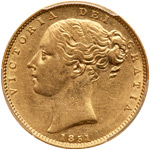 |
Great Britain. Sovereign, 1851. S.3852C; Fr-387e; KM-736.1. Weight 0.2355 ounce. Victoria. Young head left. Reverse; Crowned shield. PCGS graded AU-55. In special PCGS Ship of Gold holder which contains One Pinch of Gold Dust recovered from the S.S. Central America treasure.
Special PCGS number 674158.55/35474691. Estimated Value $500 - UP
The most notable event in the United Kingdom when this sovereign was struck was almost certainly the Great Exhibition of the Works of Industry of All Nations held in London from 1 May to 15 October 1851. While the Great Exhibition was presented as a celebration of modern technology and design its primary purpose was to respond to (and outdo) the French Industrial Exposition of 1844 and advertise the United Kingdom as the world industrial leader. The exhibits, which included a variety of inventions and materials, were housed in a massive glass and steel structure known as the Crystal Palace, which was designed and erected in the space of only nine months. The Great Exhibition was attended by many political, scientific, and literary luminaries of the period, including the likes of Charles Darwin, Karl Marx, Charles Dickens, and Charlotte Brontë and raised enough money to found several museums devoted to science and technology in Kensington.
There can be no doubt that the Great Exhibition was the great British triumph of 1851. However, the year was otherwise tarnished in the United Kingdom by the introduction of new anti-Catholic legislation in the form of the Ecclesiastical Titles Act as well as the prevention of the duly-elected David Salomons from taking his seat in Parliament. His Jewish faith made it impossible for him to swear the required oath of abjuration in its traditional Christian form and he was therefore removed. The end of the year was also blackened by a scandalous private telegram sent by Lord John Henry Palmerston, the Secretary of Foreign Affairs, to congratulate Louis Napoleon on his coup in France although the Cabinet and the Queen had insisted on maintaining neutrality. Palmerston, who was already distrusted by Queen Victoria and Prince Albert, was forced to resign.
View details and enlarged photos
Realized
$1,320 |
|
Lot 1714 |
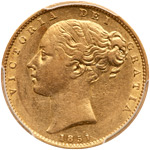 |
Great Britain. Sovereign, 1851. S.3852C; Fr-387e; KM-736.1. Weight 0.2355 ounce. Victoria. Young head left. Reverse; Crowned shield. PCGS graded AU-53. In special PCGS Ship of Gold holder which contains One Pinch of Gold Dust recovered from the S.S. Central America treasure.
Special PCGS number 674158.53/35474690. Estimated Value $500 - UP
View details and enlarged photos
Realized
$1,200 |
|
Lot 1715 |
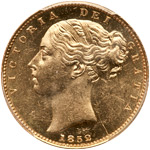 |
Great Britain. Sovereign, 1852. S.3852D; Fr-387e; KM-736.1. Weight 0.2355 ounce. Victoria. Young head. Reverse; Crowned shield. PCGS graded MS-63+. In special PCGS Ship of Gold holder which contains One Pinch of Gold Dust recovered from the S.S. Central America treasure.
Special PCGS number 674148.63+/35474680. Estimated Value $1,250 - UP
The Great Famine, which had begun in 1845 and resulted in the loss of almost a quarter of the Irish population through death and emigration to escape starvation finally came to an end in 1852. However, obstacles to safe, healthy, and adequately paid work in industrial Great Britain still remained to give a taste of hunger to many. In an attempt to fight for the rights of workers, unions began to form, including the Amalgamated Society of Engineers, Machinists, Smiths, Millwrights and Pattern-makers. When this organization decided to ban overtime and piecework in January 1852, employers retaliated with a three-month lockout.
Minor disputes between the British East India Company and the Burmese Empire regarding the Treaty of Yandabo (1826) became a flimsy excuse for beginning a Second Anglo-Burmese war on 5 April 1852. This conflict, which lasted until 20 January 1853, resulted in the British annexation of Lower Burma, a change of emperor, and the plunder of Burmese Buddhist pagodas for their gold. The entire affair, which was misrepresented by Parliament left a bad taste in the mouths of large segments of the British public and inspired a scathing anonymous pamphlet, How Wars are Got Up in India.
The year 1852 was also notable as the last in which a fatal duel took place on English soil. On 19 October, Emmanuel Barthélemy challenged his fellow French exile Frederic Cournet to a pistol duel in response to an insult to his girlfriend. Cournet was hit and died from his wound, but Barthélemy, unharmed, was later arrested and convicted of manslaughter. Two years later Barthélemy's violent ways got him into trouble again. After shooting a former policeman in an altercation, he was convicted of murder and finally hanged in 1855.
View details and enlarged photos
Realized
$4,080 |
|
Lot 1716 |
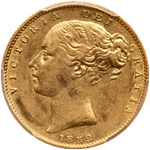 |
Great Britain. Sovereign, 1852. S.3852C; Fr-387e; KM-736.1. Weight 0.2355 ounce. Victoria. Young head. Reverse; Crowned shield. PCGS graded AU-53. In special PCGS Ship of Gold holder which contains One Pinch of Gold Dust recovered from the S.S. Central America treasure.
Special PCGS number 674148.53/35474692. Estimated Value $500 - UP
View details and enlarged photos
Realized
$1,110 |
|
Lot 1717 |
 |
Great Britain. Sovereign, 1852. S.3852C; Fr-387e; KM-736.1. Weight 0.2355 ounce. Victoria. Young head. Reverse; Crowned shield. PCGS graded AU-53. In special PCGS Ship of Gold holder which contains One Pinch of Gold Dust recovered from the S.S. Central America treasure.
Special PCGS number 674148.53/35474730. Estimated Value $500 - UP
View details and enlarged photos
Realized
$1,140 |
|
Lot 1718 |
 |
Great Britain. Sovereign, 1852. S.3852D; Fr-387e; KM-736.1. Weight 0.2355 ounce. Victoria. Young head. Reverse; Crowned shield. PCGS graded AU-53. In special PCGS Ship of Gold holder which contains One Pinch of Gold Dust recovered from the S.S. Central America treasure.
Special PCGS number 674148.53/35474738. Estimated Value $500 - UP
View details and enlarged photos
Realized
$1,200 |
|
Lot 1719 |
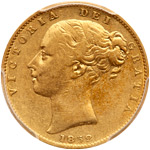 |
Great Britain. Sovereign, 1852. S.3852C; Fr-387e; KM-736.1. Weight 0.2355 ounce. Victoria. Young head. Reverse; Crowned shield. PCGS graded EF-45. In special PCGS Ship of Gold holder which contains One Pinch of Gold Dust recovered from the S.S. Central America treasure.
Special PCGS number 674148.45/35474693. Estimated Value $500 - UP
View details and enlarged photos
Realized
$1,110 |
|
Lot 1720 |
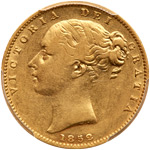 |
Great Britain. Sovereign, 1852. S.3852C; Fr-387e; KM-736.1. Weight 0.2355 ounce. Victoria. Young head. Reverse; Crowned shield. PCGS graded EF-45. In special PCGS Ship of Gold holder which contains One Pinch of Gold Dust recovered from the S.S. Central America treasure.
Special PCGS number 674148.45/35474742. Estimated Value $500 - UP
View details and enlarged photos
Realized
$1,080 |
|
Lot 1721 |
 |
Great Britain. Sovereign, 1852. S.3852C; Fr-387e; KM-736.1. Arabic 1. Weight 0.2355 ounce. Victoria. Young head. Reverse; Crowned shield. PCGS graded About Uncirculated Details (Bent). In special PCGS Ship of Gold holder which contains One Pinch of Gold Dust recovered from the S.S. Central America treasure.
Special PCGS number 674148.98/35474721. Estimated Value $500 - UP
View details and enlarged photos
Realized
$1,020 |
|
Lot 1722 |
 |
Great Britain. Sovereign, 1854. S.3852D; Fr-387e; KM-736.1. WW Incuse. Weight 0.2355 ounce. Victoria. Young head. Reverse; Crowned shield. PCGS graded About Uncirculated Details (Scratch). In special PCGS Ship of Gold holder which contains One Pinch of Gold Dust recovered from the S.S. Central America treasure.
Special PCGS number 674284.95/35474743. Estimated Value $500 - UP
View details and enlarged photos
Realized
$1,680 |
|
Lot 1723 |
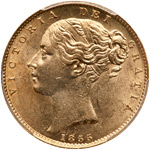 |
Great Britain. Sovereign, 1855. S.3852D; Fr-387e; KM-736.1. Weight 0.2355 ounce. Victoria. Young head. Reverse; Crowned shield. PCGS graded MS-62. In special PCGS Ship of Gold holder which contains One Pinch of Gold Dust recovered from the S.S. Central America treasure.
Special PCGS number 674149.62/35474681. Estimated Value $800 - UP
On the night of 15 May 1855, a train shipment of three boxes of gold coins and bullion from London to Paris was robbed by four men, William Tester, James Burgess, Edward Agar, and William Pierce. This high-profile robbery was known in contemporary papers as the Great Gold Robbery and involved the use of wax impressions of safe keys and inside involvement from employees of the South Eastern Railway. The robbers emptied the railway safes of some 224 pounds of gold valued at £12,000 at the time and left no clues for the authorities as to who had done it or even where the crime had taken place. There was dispute as to whether the robbery had taken place on the English or the French side of the Channel. However, when the career criminal Edward Agar was arrested on another crime, he asked Pierce to provide money to his girlfriend and child. When Pierce failed to help, she went to Newgate Prison and gave authorities there the names of the robbers. Abgar subsequently turned Queen's Evidence against his associates, who were all arrested and convicted. Pierce received a sentence of two-years' hard labor in England while Tester and Burgess suffered transportation to Australia for 14-years.
These criminal escapades of 1840 were later popularized by Michael Chrichton in the 1975 novel, The Great Train Robbery, and its 1979 film adaptation starring Sean Connery and Donald Sutherland.
View details and enlarged photos
Realized
$1,680 |
|
Lot 1724 |
 |
Great Britain. Sovereign, 1856. S.3852D; Fr-387e; KM-736.1. Weight 0.2355 ounce. Victoria. Young head. Reverse; Crowned shield. PCGS graded MS-62. In special PCGS Ship of Gold holder which contains One Pinch of Gold Dust recovered from the S.S. Central America treasure.
Special PCGS number 674251.62/35474740. Estimated Value $800 - UP
On 30 March 1856, the Treaty of Paris was signed by Great Britain, France, the Ottoman Empire, and Russia in order to bring about an end of the bloody Crimean War (1853-1856). Despite the fall of Sevastopol after a siege of more than a year, by 1856 the war had become very unpopular in the United Kingdom due to inept leadership and disastrous losses in actions like the infamous Charge of the Light Brigade at the battle of Balaclava (1854). At the Congress of Paris leading up to the treaty, the British pressed for the inclusion of clauses that would punish Russia harshly for the conflict, but these were ultimately dropped through the influence of France, which had no real interest in the Balkans, but hoped to capitalize on a weakened, but not destroyed Russian Empire. Nevertheless, British trade profited from the provision of the treaty that demilitarized the Black Sea and left its ports available to trade by ships belonging to subjects of any of the victorious allies.
Prior to the peace treaty, on 29 January 1856, Queen Victoria instituted a new military medal known as the Victoria Cross. It was to be awarded to British soldiers of the Crimean War (and subsequent conflicts) regardless of birth or class in recognition of signal acts of valor on the battlefield. The Victoria Cross was bestowed upon its first recipients after their return from the Crimea in 1857. It became, and still remains, the highest military honor in the United Kingdom.
View details and enlarged photos
Realized
$1,980 |
|
Lot 1725 |
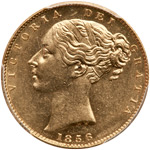 |
Great Britain. Sovereign, 1856. S.3852D; Fr-387e; KM-736.1. Weight 0.2355 ounce. Victoria. Young head. Reverse; Crowned shield. PCGS graded MS-61. In special PCGS Ship of Gold holder which contains One Pinch of Gold Dust recovered from the S.S. Central America treasure.
Special PCGS number 674251.61/35474711. Estimated Value $600 - UP
View details and enlarged photos
Realized
$1,680 |
|
Lot 1726 |
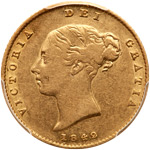 |
Great Britain. ½ Sovereign, 1842. S.3859; Fr-389b; KM-735.1. Weight 0.1177 ounce. Victoria. Young head. Reverse; Crowned shield. PCGS graded EF-45. In special PCGS Ship of Gold holder which contains One Pinch of Gold Dust recovered from the S.S. Central America treasure.
Special PCGS number 674153.45/35474686. Estimated Value $500 - UP
View details and enlarged photos
Realized
$870 |
|
Lot 1727 |
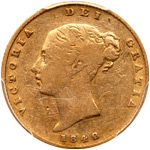 |
Great Britain. ½ Sovereign, 1842. S.3859; Fr-389b; KM-735.1. Weight 0.1177 ounce. Victoria. Young head. Reverse; Crowned shield. PCGS graded VF-35. In special PCGS Ship of Gold holder which contains One Pinch of Gold Dust recovered from the S.S. Central America treasure.
Special PCGS number 674153.35/35474700. Estimated Value $500 - UP
View details and enlarged photos
Realized
$900 |
|
Lot 1728 |
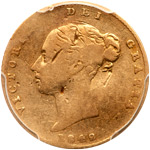 |
Great Britain. ½ Sovereign, 1842. S.3859; Fr-389b; KM-735.1. Weight 0.1177 ounce. Victoria. Young head. Reverse; Crowned shield. PCGS graded Fine Details (Damage). In special PCGS Ship of Gold holder which contains One Pinch of Gold Dust recovered from the S.S. Central America treasure.
Special PCGS number 674153.98/35474685. Estimated Value $500 - UP
View details and enlarged photos
Realized
$750 |
|
Lot 1729 |
 |
Great Britain. ½ Sovereign, 1845. S.3859; Fr-389b; KM-735.1. Weight 0.1177 ounce. Victoria. Young head. Reverse; Crowned shield. Scarce date. PCGS graded VF-25. In special PCGS Ship of Gold holder which contains One Pinch of Gold Dust recovered from the S.S. Central America treasure.
Special PCGS number 676904.25/35671943. Estimated Value $500 - UP
View details and enlarged photos
Realized
$810 |
|
Lot 1730 |
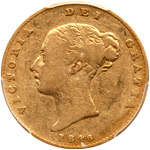 |
Great Britain. ½ Sovereign, 1846. S.3859; Fr-389b; KM-735.1. Weight 0.1177 ounce. Victoria. Young head. Reverse; Crowned shield. PCGS graded VF-30. In special PCGS Ship of Gold holder which contains One Pinch of Gold Dust recovered from the S.S. Central America treasure.
Special PCGS number 674136.30/35474718. Estimated Value $500 - UP
View details and enlarged photos
Realized
$840 |
|
Lot 1731 |
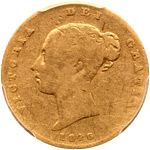 |
Great Britain. ½ Sovereign, 1846. S.3859; Fr-389b; KM-735.1. Weight 0.1177 ounce. Victoria. Young head. Reverse; Crowned shield. PCGS graded VG-10. In special PCGS Ship of Gold holder which contains One Pinch of Gold Dust recovered from the S.S. Central America treasure.
Special PCGS number 674136.10/35474676. Estimated Value $500 - UP
View details and enlarged photos
Realized
$750 |
|
Lot 1732 |
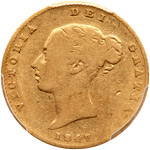 |
Great Britain. ½ Sovereign, 1847. S.3859; Fr-389b; KM-735.1. Weight 0.1177 ounce. Victoria. Young head. Reverse; Crowned shield. PCGS graded Fine-12. In special PCGS Ship of Gold holder which contains One Pinch of Gold Dust recovered from the S.S. Central America treasure.
Special PCGS number 674154.12/35474687. Estimated Value $500 - UP
View details and enlarged photos
Realized
$750 |
|
Lot 1733 |
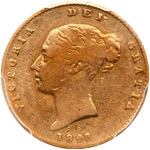 |
Great Britain. ½ Sovereign, 1848. S.3859; Fr-389b; KM-735.1. Weight 0.1177 ounce. Victoria. Young head left. Reverse; Crowned shield. PCGS graded VF-30. In special PCGS Ship of Gold holder which contains One Pinch of Gold Dust recovered from the S.S. Central America treasure.
Special PCGS number 674167.30/35474701. Estimated Value $500 - UP
View details and enlarged photos
Realized
$780 |
|
Lot 1734 |
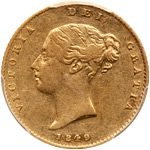 |
Great Britain. ½ Sovereign, 1849. S.3859; Fr-389b; KM-735.1. Weight 0.1177 ounce. Victoria. Young head left. Reverse; Crowned shield. PCGS graded AU-50. In special PCGS Ship of Gold holder which contains One Pinch of Gold Dust recovered from the S.S. Central America treasure.
Special PCGS number 674261.50/35474719. Estimated Value $500 - UP
View details and enlarged photos
Realized
$960 |
|
Lot 1735 |
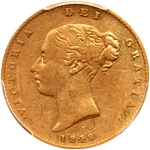 |
Great Britain. ½ Sovereign, 1849. S.3859; Fr-389b; KM-735.1. Weight 0.1177 ounce. Victoria. Young head left. Reverse; Crowned shield. PCGS graded AU-50. In special PCGS Ship of Gold holder which contains One Pinch of Gold Dust recovered from the S.S. Central America treasure.
Special PCGS number 674261.50/35474728. Estimated Value $500 - UP
View details and enlarged photos
Realized
$960 |
|
Lot 1736 |
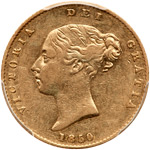 |
Great Britain. ½ Sovereign, 1850. S.3859; Fr-389b; KM-735.1. Weight 0.1177 ounce. Victoria. Young head left. Reverse; Crowned shield. Scarce date. PCGS graded AU-53. In special PCGS Ship of Gold holder which contains One Pinch of Gold Dust recovered from the S.S. Central America treasure.
Special PCGS number 674247.53/35474709. Estimated Value $500 - UP
View details and enlarged photos
Realized
$960 |
|
Lot 1737 |
 |
Great Britain. ½ Sovereign, 1852. S.3859; Fr-389b; KM-735.1. Weight 0.1177 ounce. Victoria. Young head. Reverse; Crowned shield. PCGS graded AU-50. In special PCGS Ship of Gold holder which contains One Pinch of Gold Dust recovered from the S.S. Central America treasure.
Special PCGS number 674156.50/35474724. Estimated Value $500 - UP
View details and enlarged photos
Realized
$810 |
|
Lot 1738 |
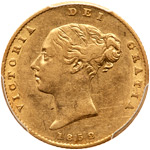 |
Great Britain. ½ Sovereign, 1852. S.3859; Fr-389b; KM-735.1. Weight 0.1177 ounce. Victoria. Young head. Reverse; Crowned shield. PCGS graded AU-50. In special PCGS Ship of Gold holder which contains One Pinch of Gold Dust recovered from the S.S. Central America treasure.
Special PCGS number 674156.50/35474688. Estimated Value $500 - UP
View details and enlarged photos
Realized
$810 |
|
Lot 1739 |
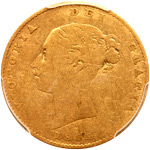 |
Great Britain. ½ Sovereign, 1852. S.3859; Fr-389b; KM-735.1. Weight 0.1177 ounce. Victoria. Young head. Reverse; Crowned shield. PCGS graded VG-10. In special PCGS Ship of Gold holder which contains One Pinch of Gold Dust recovered from the S.S. Central America treasure.
Special PCGS number 674156.10/35474729. Estimated Value $500 - UP
View details and enlarged photos
Realized
$780 |
|
Lot 1740 |
 |
Great Britain. ½ Sovereign, 1853. S.3859; Fr-389b; KM-735.1. Weight 0.1177 ounce. Victoria. Young head. Reverse; Crowned shield. PCGS graded AU-53. In special PCGS Ship of Gold holder which contains One Pinch of Gold Dust recovered from the S.S. Central America treasure.
Special PCGS number 674276.53/35474734. Estimated Value $500 - UP
View details and enlarged photos
Realized
$1,260 |
|
Lot 1741 |
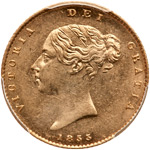 |
Great Britain. ½ Sovereign, 1855. S.3859; Fr-389b; KM-735.1. Weight 0.1177 ounce. Victoria. Young head. Reverse; Crowned shield. PCGS graded AU-58. In special PCGS Ship of Gold holder which contains One Pinch of Gold Dust recovered from the S.S. Central America treasure.
Special PCGS number 676900.58/35671944. Estimated Value $500 - UP
In 1855 it became clear to Great Britain and her French and Ottoman allies that the ongoing Crimean War (1853-1856) would soon conclude with victory over the Russians. Nevertheless, by this time the war, which had been badly mismanaged in 1854, was becoming increasingly unpopular. On 9 January 1855, the coalition government of George Hamilton-Gordon, collapsed in a non-confidence vote and resulted in his resignation as Prime Minister on 5 February. Nevertheless, the end of the conflict was actually slowly drawing nearer.
The British and French had been besieging the Russian garrison in Sevastopol since 17 October 1854, but by late summer of 1855 they were finally poised to take the city thanks to the completion of a new rail line that brought supplies and munitions to the siege works from Balaclava. On 5 September, British and French ships began the bombardment of Sevastopol with 307 guns causing the Russian garrison to suffer 2-3,000 casualties per day. At last, on 8 September, the Anglo-French forces made their final assault on the city. Although the British failed to take the defensive position known as the Great Redan, the French success against the Malakoff redoubt compelled the Russians to abandon Sevastopol and begin to consider peace terms. In the aftermath of the costly allied victory, Russian cannon captured by the British were sent home to Great Britain for prominent display in many towns. It was suggested that the Victoria Cross, a British military medal for bravery instituted in the following year, should be made from bronze taken from the cannon seized at Sevastopol, but modern metallurgical testing has shown that this suggestion was not followed.
View details and enlarged photos
Realized
$1,560 |
|
|
|